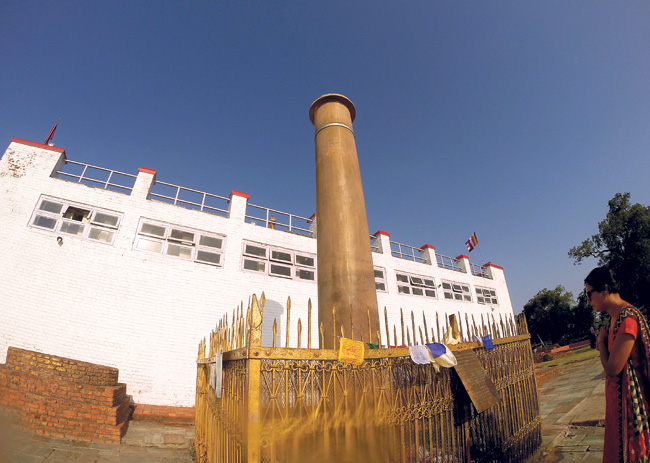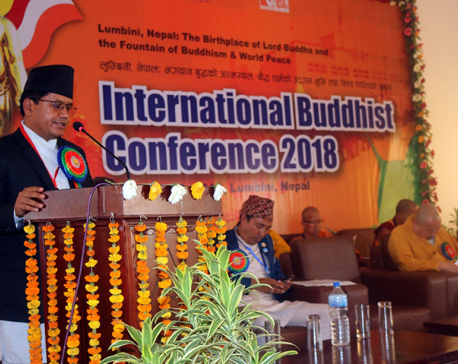
OR

Interestingly, all of Lord Buddha’s major life events occurred under a tree. From his birth and his enlightenment to his first discourse and his
death, all happened underneath a tree.
The birthplace of Lord Buddha, Lumbini literally translates to “the lovely” in Sanskrit. It was declared a World Heritage Site by UNESCO in 1997. According to the Buddhist traditions, Maya Devi game birth to Buddha when she was on her way to her parents’ house in Devadaha in 642 BC on her tenth month of pregnancy.
With the onset of labor, she is said to have taken a bath in the puskarini pond and given birth to Prince Siddhartha while standing up and holding on to the branches of the Sal tree. The traditions cite that upon his birth, he spoke the words “this is my final rebirth” and walked seven steps, under which lotus flowers bloomed. Interestingly, all of Lord Buddha’s major life events occurred under a tree. From his birth and his enlightenment to his first discourse and his death, all happened underneath a tree.
The best times to visit Lumbini are from October to May. If you plan on making a visit this year, know that June to September is the rainy season. Make sure you carry an umbrella or a raincoat.
How to get there
Siddhartha Highway connects Lumbini by road to Pokhara, Tansen and Kathmandu. There are buses available in these routes that depart every day. Alternatively, you can decide to drive there yourself or book a vehicle through a travel agency. There are also regular flights from Kathmandu to Siddharthanagar, which is a 20 minutes drive from Lumbini. Reliance travels in Thamel can help you figure out your transportation as well as offer a weekend itinerary.
What to do
In the foothills of the Himalayas, Lumbini is a large garden with groves of peepal trees. Although the area around it is largely Hindu, there are many Buddhist shrines and temples from various nations around the holy site.
Maya Devi Temple
This temple is built on the site of the birthplace of Buddha, which is known as the sacred garden, and you are required to pay a small amount to enter it. The 1992 excavations on the site revealed ruins that date back at least 2200 years. It included a commemorative stone on a brick plinth that matches the description of a stone that was lain down by King Ashoka in the 3rd century BC. You must remove your shoes at the gate to enter and you can walk around in a raised boardwalk to view the ruins.
The focal point of the temple is the stone marker which is placed inside bulletproof glass and pinpoints the spot of Buddha’s birth. There are also the puskarini pond and the ruins of foundations of many brick monasteries and stupas that date from the 2nd to the 9th century AD that you can view from the premises.
Ashoka Pillar
King Ashoka is believed to have visited Lumbini after having converted to Buddhism and erected a pink sandstone pillar to mark the birthplace of Gautam Buddha. It is also the oldest inscription found in Nepal by a team of archeologists led by Kadga Shamsher Rana and assisted by Alois Anton Fuhrer.
 It was moved away from the site it was found at and now stands tall right next to the Maya Devi temple. The inscription of the pillar has been roughly translated to “King Piyadasi (Ashoka), beloved of devas, in the 20th year of coronation, himself made a royal visit, Buddha Sakyamuni having been born here; a stone railing was built and a stone pillar erected to the Bhagavan having been born here, Lumbini village was tax reduced and entitled to the eight part (only).”
It was moved away from the site it was found at and now stands tall right next to the Maya Devi temple. The inscription of the pillar has been roughly translated to “King Piyadasi (Ashoka), beloved of devas, in the 20th year of coronation, himself made a royal visit, Buddha Sakyamuni having been born here; a stone railing was built and a stone pillar erected to the Bhagavan having been born here, Lumbini village was tax reduced and entitled to the eight part (only).”
Explore the monasteries
There are many different monasteries that have been built in Lumbini. They include the Myanmar Golden Temple, Royal Thai Monastery, Chinese Monastery and The Great Lotus Stupa, German Monastery. There are many other Monasteries from different countries in the surrounding areas, all of which will leave you feeling peaceful and happy. Each of the monasteries has their own design and significance and is constantly being renovated and new ones are being constructed as well. The Myanmar Temple, also known as Lokamani Cula Pagoda, is a gleaming white and gold graceful structure in the Shwe-dagon style Pagoda in Yangon. The China temple has pagodas, meditation cells, and prayer rooms. The Japanese Peace stupa is located at the northern side of Lumbini. At 41 meters, it is visible from a distance. Exploring all the monasteries might even mean that you have to plan a week’s stay in Lumbini.
You May Like This

State-5 government gears up for Lumbini Visit Year for tourism promotion
RUPANDEHI, March 16: State-5 government has intensified the preparations to mark the New Year 2076 BS as the Lumbini Visit... Read More...

Master plan of Lumbini to be finalized within two years-Tourism Minister
RUPANDEHI, April 28: Minister for Culture, Tourism and Civil Aviation Rabindra Adhikari has said Lumbini has been the pilgrimage site... Read More...

New leadership takes over Radio Lumbini
BUTWAL, Dec 14: The Radio Lumbini on Tuesday elected a new working committee unopposed coinciding with the occasion of its... Read More...




Just In
- Govt receives 1,658 proposals for startup loans; Minimum of 50 points required for eligibility
- Unified Socialist leader Sodari appointed Sudurpaschim CM
- One Nepali dies in UAE flood
- Madhesh Province CM Yadav expands cabinet
- 12-hour OPD service at Damauli Hospital from Thursday
- Lawmaker Dr Sharma provides Rs 2 million to children's hospital
- BFIs' lending to private sector increases by only 4.3 percent to Rs 5.087 trillion in first eight months of current FY
- NEPSE nosedives 19.56 points; daily turnover falls to Rs 2.09 billion















Leave A Comment